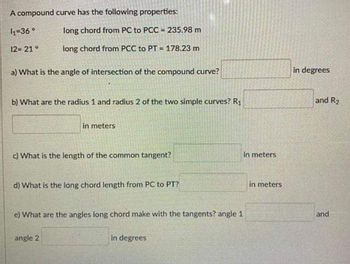
Structural Analysis
6th Edition
ISBN: 9781337630931
Author: KASSIMALI, Aslam.
Publisher: Cengage,
expand_more
expand_more
format_list_bulleted
Concept explainers
Question
thumb_up100%

Transcribed Image Text:A compound curve has the following properties:
long chord from PC to PCC 235.98 m
long chord from PCC to PT = 178.23 m
a) What is the angle of intersection of the compound curve?
1₁-36°
12= 21°
b) What are the radius 1 and radius 2 of the two simple curves? R₁
in meters
c) What is the length of the common tangent?
d) What is the long chord length from PC to PT?
e) What are the angles long chord make with the tangents? angle 1
angle 2
in degrees
in meters
in meters
in degrees
and R₂
and
Expert Solution
This question has been solved!
Explore an expertly crafted, step-by-step solution for a thorough understanding of key concepts.
Step by stepSolved in 4 steps with 1 images

Knowledge Booster
Learn more about
Need a deep-dive on the concept behind this application? Look no further. Learn more about this topic, civil-engineering and related others by exploring similar questions and additional content below.Similar questions
- In a lake the water is moving and at each point in the lake there is a velocity vector so, we have a well-defined velocity field V at any point of the lake. Let us consider a thinkable curve C in the S. lake. Then the line integral V.T ds from the velocity field V with respect to the arc-length C measure over the curve (path) C sums (adds up) the tangent components to the curve C of the velocity field V along the points on the curve C. In this sense, the line integral measures how much of the water (the fluid) is aligned with the curve C. In other words, the above line integral measures, indicates how much of the water (the fluid) tends to circulate around the curve C. Hence, we define the circulation s done by the velocity field V around the curve C as r= V.T ds C In physics, circulation is the line integral of a vector field around a close curve. In fluid dynamics the field is the fluid velocity field. In electrodynamics, it can be the electric or the magnetic field. Suppose that a…arrow_forwardThe azimuths of the back and forward tangent of a spiral curve are 220° and 290° respectively. If the length of the spiral is 80m and the degree of the circular curve is 4°, determine: a. The distance between the vertex and the middle of the curve. b. The short tangent at the SC point. c. The long tangent at the SC point. d. The station of CS if the station of TS is at (7+028).arrow_forwardGiven for a compound curve: plus of PI = 14 + 29.31 , Δ = 97 ° 35 ′ 15 ″ ; the first radius R 1 = 400 ′ , Δ 1 = 63 ° 22 ′ 18 ″ , R 2 = 800 ′ . Compute the pluses of PC, PCC, and PT and the lengtharrow_forward
Recommended textbooks for you

 Structural Analysis (10th Edition)Civil EngineeringISBN:9780134610672Author:Russell C. HibbelerPublisher:PEARSON
Structural Analysis (10th Edition)Civil EngineeringISBN:9780134610672Author:Russell C. HibbelerPublisher:PEARSON Principles of Foundation Engineering (MindTap Cou...Civil EngineeringISBN:9781337705028Author:Braja M. Das, Nagaratnam SivakuganPublisher:Cengage Learning
Principles of Foundation Engineering (MindTap Cou...Civil EngineeringISBN:9781337705028Author:Braja M. Das, Nagaratnam SivakuganPublisher:Cengage Learning Fundamentals of Structural AnalysisCivil EngineeringISBN:9780073398006Author:Kenneth M. Leet Emeritus, Chia-Ming Uang, Joel LanningPublisher:McGraw-Hill Education
Fundamentals of Structural AnalysisCivil EngineeringISBN:9780073398006Author:Kenneth M. Leet Emeritus, Chia-Ming Uang, Joel LanningPublisher:McGraw-Hill Education
 Traffic and Highway EngineeringCivil EngineeringISBN:9781305156241Author:Garber, Nicholas J.Publisher:Cengage Learning
Traffic and Highway EngineeringCivil EngineeringISBN:9781305156241Author:Garber, Nicholas J.Publisher:Cengage Learning


Structural Analysis (10th Edition)
Civil Engineering
ISBN:9780134610672
Author:Russell C. Hibbeler
Publisher:PEARSON

Principles of Foundation Engineering (MindTap Cou...
Civil Engineering
ISBN:9781337705028
Author:Braja M. Das, Nagaratnam Sivakugan
Publisher:Cengage Learning

Fundamentals of Structural Analysis
Civil Engineering
ISBN:9780073398006
Author:Kenneth M. Leet Emeritus, Chia-Ming Uang, Joel Lanning
Publisher:McGraw-Hill Education


Traffic and Highway Engineering
Civil Engineering
ISBN:9781305156241
Author:Garber, Nicholas J.
Publisher:Cengage Learning